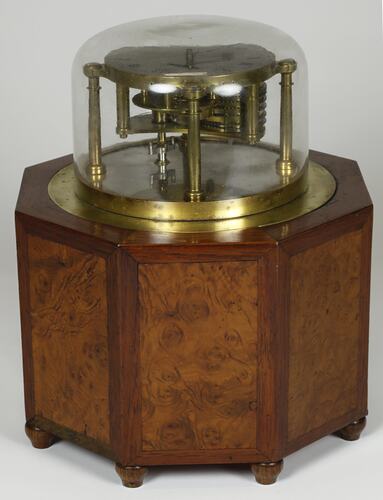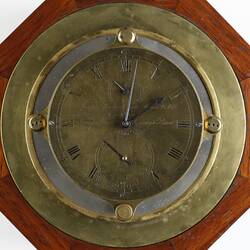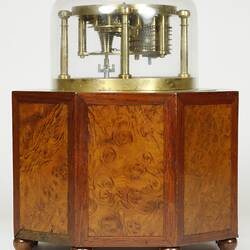Summary
Vacuum clock, consisting of a brass clock under an evacuated glass dome. Made by Joseph Manton, London, circa 1810.
Joseph Manton (1760-1835) was a celebrated English gunsmith.
In a letter to the Commissioners of Longitude in March 1807, Joseph Manton stated: "My invention is to put the whole of the Time-keeper into a Vacuum, so constructed that it may be wound up when required without admitting the external Air. The advantages of having the Time Keeper in a Vacuum, are, the Vibration of the Balance or Pendulum will be more uniform, and act with less friction - the Sea Air, Damps and Dust will be excluded, which are so injurious in rusting, and corroding the movements of Time-Keepers in long voyages; and the Oil will be in a more unifrom fluid State, by not being exposed to the alteration of the Atmosphere, which must have the effect of making a Time-keeper go much truer and nearer prefection that any hitherto constructed." [Neal and Black, 1966, p150-151]
Joseph Manton had been unaware at that time that the idea of using vacuum had already been published in 1714 by Jeremiah Thacker and John Roberts. Ultimately, Manton's clock was not deemed to have been accurate enough for use as a chronometer, despite the use of a vacuum.
Physical Description
Brass clock under evacuated glass dome, supported by octagonal box with door. Has taps inside box. Spring wound; detent escapement.
More Information
-
Collecting Areas
-
Acquisition Information
Loan & Subsequent Bequest from Mr John Askew, 12 Sep 1928
-
Maker
Mr Joseph Manton, London, England, Great Britain, circa 1810
-
Inscriptions
Dial is marked 'Joseph Manton Gun Maker etc etc London, Inventor & by His Majesty Patent, (Patented in 1807 no 3085)'.
-
Classification
-
Category
-
Discipline
-
Type of item
-
Overall Dimensions
208 mm (Width), 205 mm (Depth), 250 mm (Height)
-
Dimensions
24.5 cm (Height), 22 cm (Outside Diameter)
Measurement From Conservation. Measuring Method: With glass on top.
-
References
Neal, W. K. and Back, D. H. L. (1966) The mantons : gunmakers. London: Herbert Jenkins.
-
Keywords






